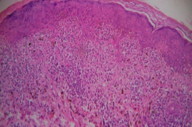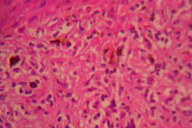Blaschkoid lichen planus: Not a Koebner phenomenon
Main Content
Blaschkoid lichen planus: Not a Koebner phenomenon
Nitin Ramchandra Lade MD, Vikrant Saoji MD, Adarsh Iata Singh MD
Dermatology Online Journal 19 (4): 17
J N Medical College Wardha, Maharashtra, IndiaAbstract
Linear lichen planus (LP) is commonly seen as an effect of the koebner phenomenon and can occur in any site. However, LP in a whorl pattern along Blaschko lines is rarely mentioned in the literature. We highlight this rare form in a 32-year-old female with multiple hyperpigmented lesions with various patterns along the lines of Blaschko on the left side of the trunk. The clinical and histological findings were suggestive of LP.
Introduction
Lichen planus is characterized by pruritic, violaceous papules that favor the extremities [1]. Various types of LP are mentioned in the literature, which includes classical, hypertrophic, ulcerative, and linear [2]. Linear lesions as a Koebner effect are described commonly. However lichen planus in a whorled pattern following Blaschko lines is rarely reported. We report a case of a 32-year-old female who developed LP along the lines of Blaschko.
Case report
A 32-year-old female patient presented with multiple mildly pruritic hyperpigmented lesions on the left side of trunk for one year. It started from the chest and then gradually progressed over the lower abdomen, back, and pelvic area. The lesions were stable for the last three months. There was no history of topical application, trauma, or prior dermatological disease. There was no family history.
 |
| Figure 1 |
|---|
| Figure 1. Hyperpigmented macules in linear, S pattern, and whorl pattern |
On cutaneous examination, lesions were localized to the left chest, abdomen, and pelvic area, extending from the left breast to the pubic area and from the lower left scapula to the pelvic crest. The lesions were hyperpigmented macules and patches arranged in a linear, S-shaped, and whorled pattern along Blaschko lines, without crossing the midline. A few violaceous papules were present within the macules (Figure 1). Hair, nail, and mucosae were normal. A differential diagnosis of Blaschkoid LP and nevoid melanosis were considered.
 |  |
| Figure 2a | Figure 2b |
|---|---|
| Figures 2a and 2b. Lichenoid infiltrates with interface dermatitis, classic for lichen planus | |
Complete blood count was normal and serology for anti HCV antibodies was negative. Histopathological examination showed hyperkeratosis with focal hypergranulosis, irregular acanthosis, and lichenoid interface dermatitis suggestive of lichen planus (Figures 2a and 2b). Considering the clinical presentation and histopathologic findings, a final diagnosis of Blaschkoid LP was made.
We gave oral prednisolone 0.5 mg/kg, which we tapered over a month. The papules completely subsided, but there was no response in pigmentation. She is still following us for post inflammatory hyperpigmentation.
Discussion
The lines of Blaschko were first described by Alfred Blaschko in 1901 [3]. In contrast to dermatomes, these lines form a V-shape over the spine and an S-shape on the lateral and anterior aspect of the trunk. On limbs, the lines run in a perpendicular direction and on the abdomen they form whorls or an ‘S’ pattern [4]. Most of the diseases described in association with Blaschko lines are congenital and include incontinentia pigmenti, hypomelanosis of Ito, and epidermal nevus [4]. However, acquired inflammatory diseases like psoriasis and eczema are also reported to follow Blaschko lines and are being termed nevoid psoriasis and Blasckitis, respectively [4]. Lichen planus in the nevoid or Blaschkoid form is rare. It represents less than 0.5 percent of LP [5]. It follows a benign course. No systemic associations have been noted with this type of LP. The exact cause of the Blaschkoid pattern of this disease has not yet been ascertained but it is considered as Blaschkitis (an acquired inflammation along Blaschko lines) without koebnerization or wolf’s isotopic response [6, 7]. Most cases of the linear as well as the zosteriform distribution of LP have been satisfactorily explained on the basis of the koebner phenomenon [2] because they appeared either secondary to some trauma or in the healed lesions of some pre-existing disease like herpes zoster. The new entity of idiopathic acquired inflammation (Blaschkitis) may well explain the cases in which there is no underlying isomorphism [8]. Similar cases of Blaschkoid lichen planus, which were late onset and involved the entire half of the body or half of the trunk have been reported in the literature [9, 10, 11]. Blaschkoid LP should not be confused with linear LP or zosteriform LP. Blaschkoid LP or nevoid LP presents in a pattern form such as whorled or ‘S’ pattern along with some linear lesions [9, 10, 11], as also seen in our case.
References
1. Boyd AS, Nelder KH. Lichen palnus. J Am Acad Dermatol. 1991;25:593-619. [PubMed]2. S.M. Breathnach. Lichen planus and Lichenoid disorder. Burn T, Breathnach S, Cox N, Griffiths C. Rook textbook of dermatology. 8th ed Blackwell science; 2010:41.12
3. Jackson R. The lines of Blaschko: A review and reconsideration: Observations of the cause of certain unusual linear conditions of the skin. Br J Dermatol 1976;95:349-60. [PubMed]
4. Bolognia JK, Orlow SJ, Glick SA. Lines of blaschko. J Am Acad Dermatol 1994;31:157-90. [PubMed]
5. Hartl C, Steen KH, Wegner H. Unilateral linear lichen planus with mucous membrane involvement. Acta Derm Venereol. 1999;79:145-6. [PubMed]
6. Bari A U, Rahman SB. Zosteriform Lichen Planus. J Col Phys Surg Pak. 2003; 13: 104-5. [PubMed]
7. Grosshans E, Marot L. Blaschkitis in adults. Ann Dermatol Venereol 1990; 117: 9-15. [PubMed]
8. Mercy P, Ghorpade A, Das MN, Soud A, Puttoo S, Sharma D, Jain A. Acquired Blaschkoid dermatitis. Indian J Dermatol Venereol Leprol 2007;73:415-6. [PubMed]
9. Ber Rahman S, U L Ban A, Mumtaz N. Unilateral Blashkoid LP involving entire half of the body, a unique presentation. Dermatol Online Journal 2007;13:36. [PubMed]
10. Widespread Blaschkoid lichen planus. Klein HA, Krathen RA, Hsu S. Dermatol Online Journal 2006;12(7):17. [PubMed]
11. Gupta S, Gupta S, Thomas M, Mahendra A. Unilateral Lichen Planus Along the Lines of Blaschko: a Rare Clinical Presentation. Acta Medica Indonesiana 2012; 44(2) : 163-4. [PubMed]
© 2013 Dermatology Online Journal


